Puff pastry is one of the best pastries to use to create savoury or sweet delights. It is flaky, buttery and feels light as you eat it. Many people choose not to make it because it is time consuming and can be difficult to produce. However, with few tips and instructions you can do it and the end result is so rewarding to your tastebuds that you will crave it again.
Puff pastry also known as “pate feuilletee” is a laminated dough. The lamination is created by layers of dough “the detrempe” and butter “the beurrage”. The lamination involves a particular technique of folding the dough and giving “turns”. After giving the pastry 6 folds and turns the pastry is ready and has 100s of layers. There are different ways to add the butter to the dough. The English method as shown in this video, The French method and the Scottish method. You can also come across of the inverted method where the pastry is folded into the butter (this is the hardest if you have a hot kitchen as the butter melt quickly).
Ingredients
Instructions
-
Making the base of the dough-La detrempe This recipe makes 1.2 kg of puff pastry
-
As i mention earlier Puff pastry takes time to make and need a lot of rest Between folds. Be organised. Gather and measure properly all your ingredients. Measure 50 g of butter out of the 450 g and keep the 400 g of butter in the fridge. Add the sugar to the sift flour
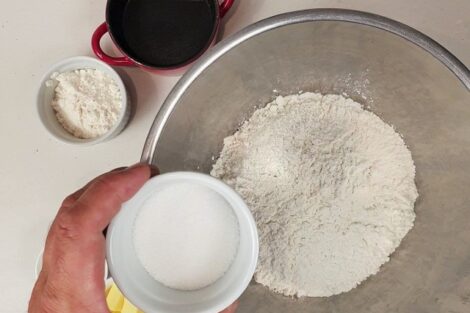
-
dice your butter and add it to the bowl.

-
Using the tip of your fingers crumble butter and flour together until it becomes a sandy texture.
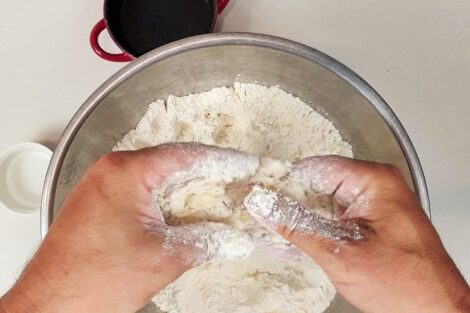
-
Keep rubbing the flour and butter together.

-
Make a well in the center of the flour

-
Add the vinegar or lemon juice. The vinegar or lemon juice is there to soften the strands of gluten and give a little elasticity to the dough.
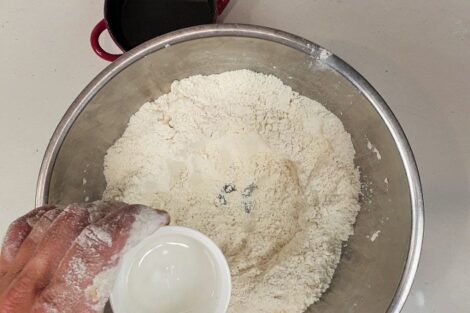
-
Add the cold water.
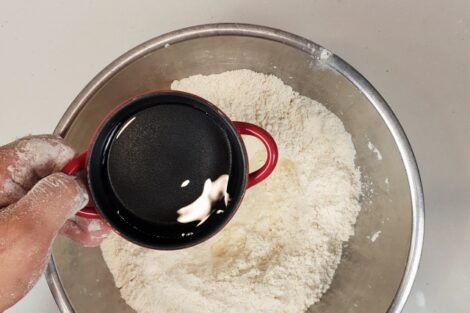
-
Using your hand, start mixing all the ingredients together.
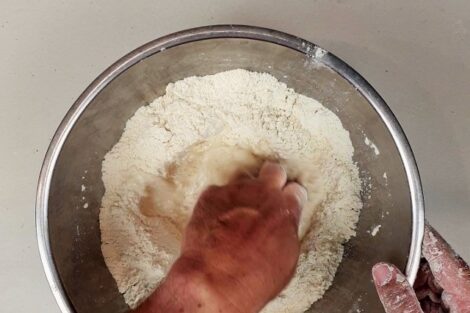
-
Keep doing it until the dough start to form.
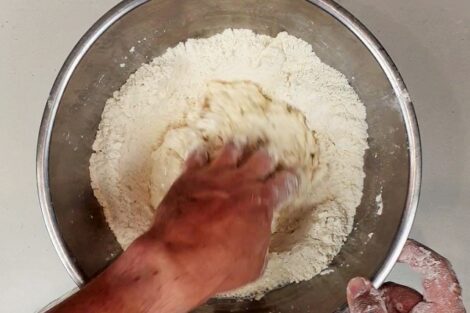
-
This should take no more than 2 minutes.
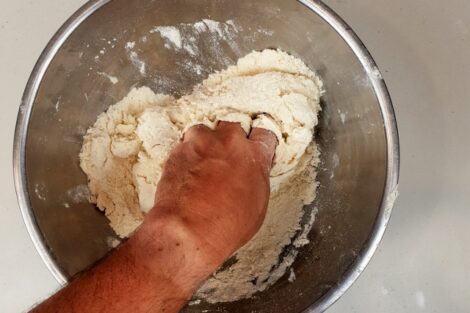
-
Once the ingredients are binding together, place your dough on the bench.. If you feel like the flour does not connect all together add few drops of water.
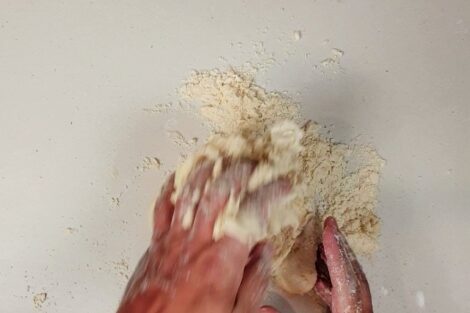
-
Using the palm of your hand, press and stretch the dough for 2 minutes only. This is to make sure that all ingredients are all well combined... Here we are not looking for a smooth dough as we do not want to work the elasticity of the dough.

-
shape a ball. It will not look smooth and this is normal. you have just made a "detrempe"
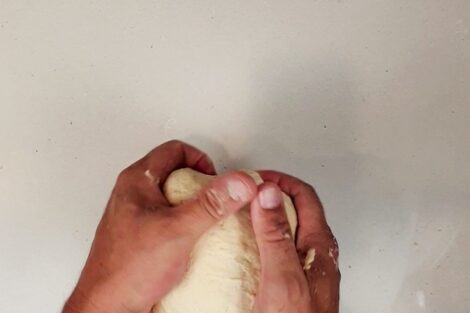
-
Traditionally, we used to cut the dough like this to prepare for the folding of the butter

-
Cover with plastic wrap and refrigerate for 1 hour.
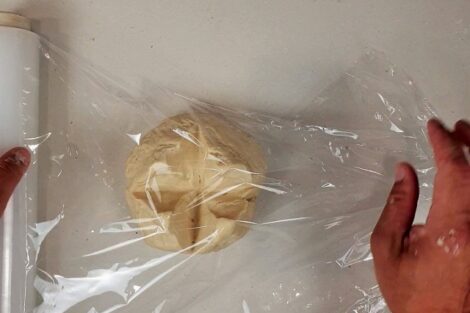 Preparing the butter
Preparing the butter
-
Leave your butter at room temperature to soften a bit.

-
Using some baking paper you can prepare your butter. Here we are looking to shape the butter to be of a rectangular size, even thickness, soft and pliable but not too soft.
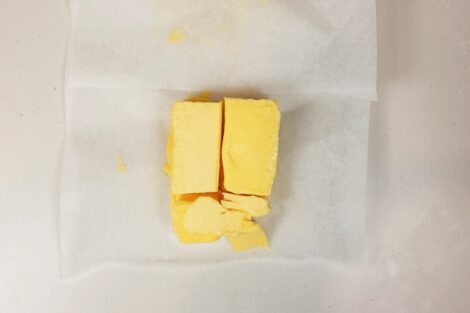
-
I left my butter outside for 5 min as it was 34°c in my kitchen. you may need to leave it longer if your kitchen is cold. i put another piece of paper on top of the butter and start to bash it with my rolling pin or my hand. i turn the butter upside down to make sure all the butter as the same texture....
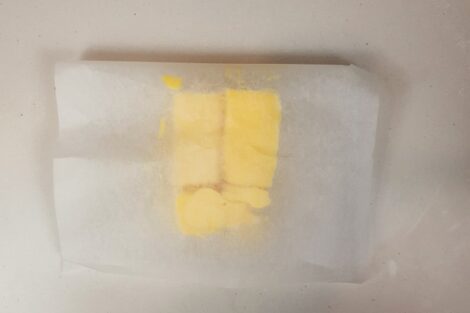
-
Using silicon paper or baking paper press, push the butter to make the butter soft and pliable. i make sure it is all pliable and start to shape and roll my butter to a rectangular size

-
Once all your butter is soft enough, roll the butter into a rectangular shape of even thickness 15 cm x 10 cm . Keep the butter in the Fridge
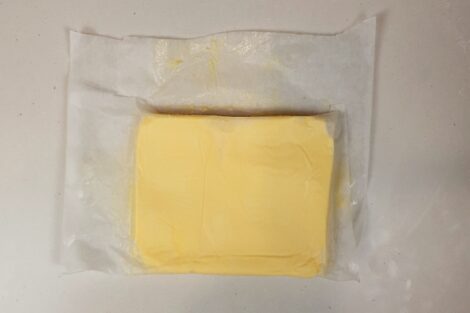 Incorporating the Butter-Le Beurrage
Incorporating the Butter-Le Beurrage
-
I remove the butter from the fridge and leave it on the bench. Meanwhile i dust my bench with a bit of flour and place the dough a front of me. Puff Pastry is beautiful and lift naturally when baking. This is happening because of the layers we are creating with butter and dough. When the pastry is baking the butter melt, releasing steam and push the dough upward. Sprinkle some flour on your bench and bring your butter to room temperature. the key success here is that your butter is of the same texture as your dough. cold but pliable..
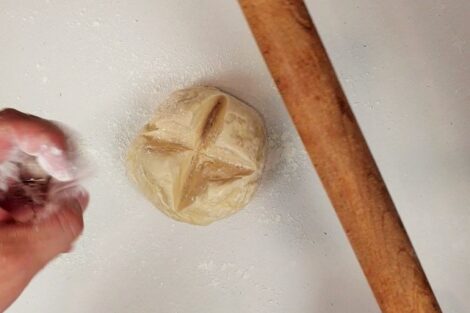
-
Using a rolling pin, roll out your dough to a rectangular shape. 30 cm X 20 cm
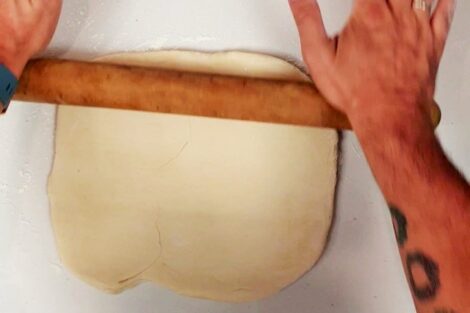
-
Grab your butter, place it to the bottom half of your rectangle and check if the top half of the dough can "JUST" cover the butter. Here i can see i need to roll out the pastry a little longer as the pastry won t cover the butter.

-
If it can just cover it is perfect, remove the paper and we will proceed. If the dough does not cover it, just roll our the dough a little more and check again. If you have roll out the dough way too much, you will have to roll out the butter a little more too. the principle here is that we do not want to have too much dough without a butter layer as this will prevent to dough to rise.
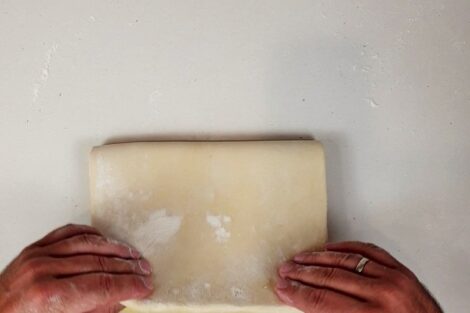
-
As you see here, the butter just fit in the bottom half of my dough leaving me no more than 5 mm the edge
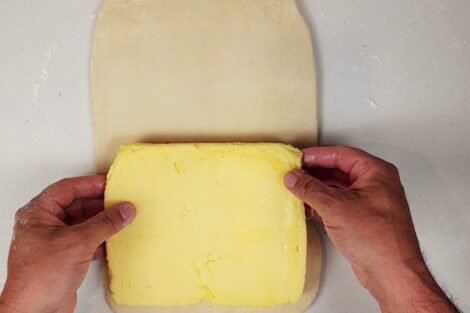
-
Cover the butter with the top half of the pastry.
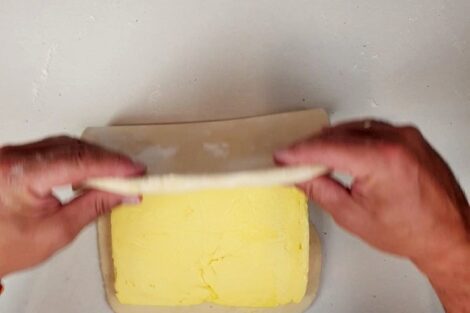
-
Seal the edges by pinching the pastry. here we really want to enclose the butter inside the pastry to prevent it running out or sticking on the bench whilst layering the pastry.
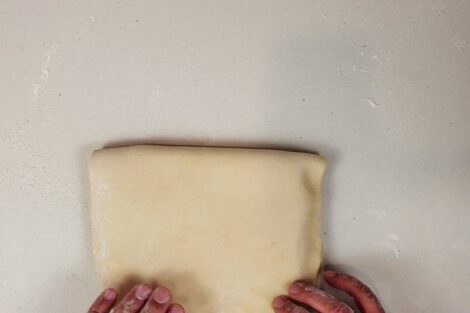
-
As you see in this photo the "ply" is on the left hand-side and i always use this technique to remember how i do my folds. Check again that the pastry is seal and the butter well enclosed.
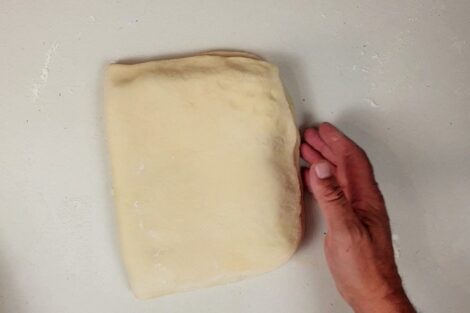 Turns and folds
Turns and folds
-
Once you have seal the pastry and check that the butter is not too hard, add a bit of flour on your bench and you can start rolling the dough a front of you.

-
Use the rolling pin going forward and backward and always in the same direction. Check that the pastry does not stick on your bench. If it odes add a bit of flour on your bench.
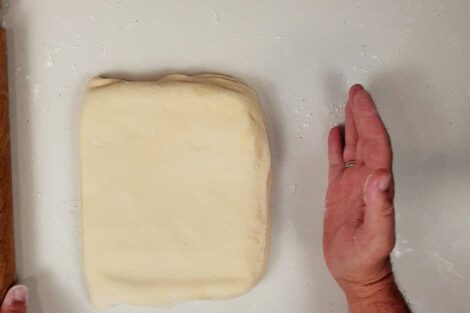
-
Roll gently but fast enough.
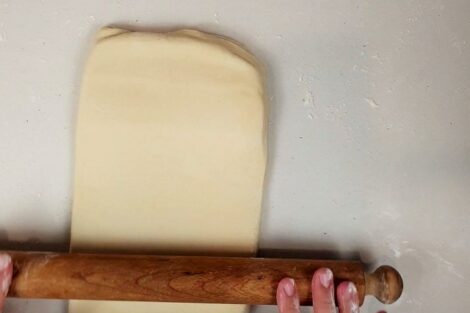
-
As we roll we want to keep that rectangular shape. So, with your hands always try to correct or adjust the shape by pushing on the sides of the dough.

-
Shape the pastry and roll the dough till its about 60 cm long and 20 cm wide.
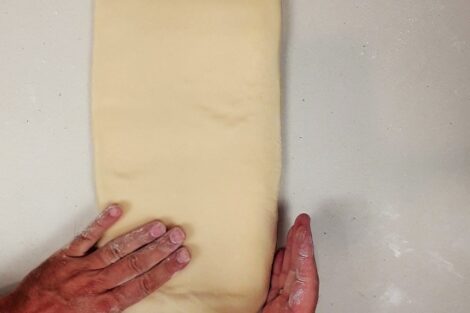
-
Here we are going to fold the dough to create 3 layers. Imagine you divide the dough in 3 parts. Take the top third of the pastry and bring it to 2/3 rd of the pastry.
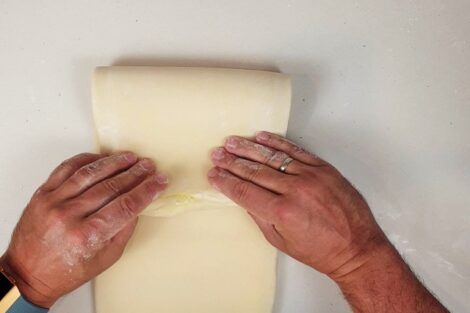
-
Then take the bottom third and place it over the top of the layer you just made.
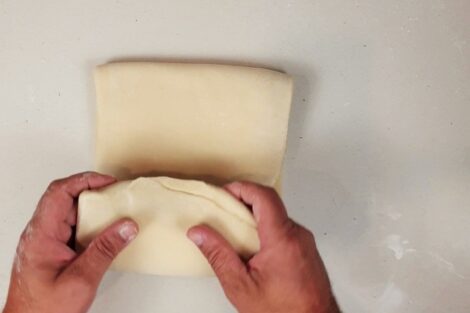
-
It should look like this. You have just create a fold, well done. This is the folding techniques that create so many layers and that we will repeat 5 more times. But wait.

-
Once this is done grab your pastry and turn it clockwise by 90°. This is your 1st turn. Puff pastry requires you to do it 5 more times. But before you can do that you must rest the dough.
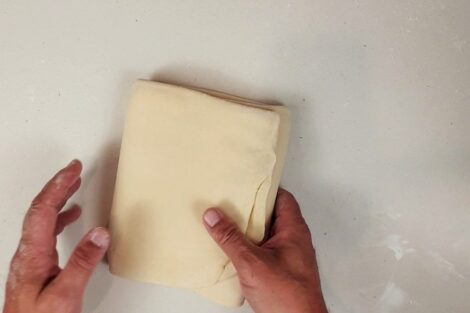
-
Cover your dough in plastic wrap and place in the fridge to rest for at least 30 min. this will make the dough less elastic, easy to roll. Do not neglect the resting time. You can let the dough rest 2 hours between turns this is not an issue
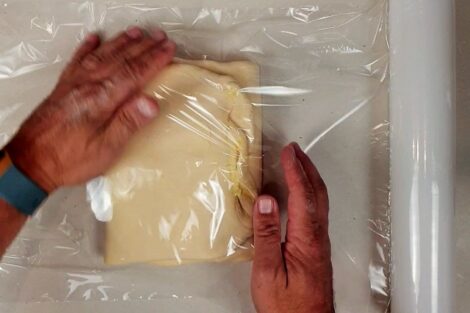
-
Place the dough on the bench as you finished the first turn with the big "ply" on your left hand-side. Once your dough is rested always allow 10 to 15 minutes for the dough to get back to room temperature. This means for the butter to soften a bit. If your butter is too hard and you try to roll out the dough, the edge of the dough will crack and the butter will look fragmented through the dough.. This result to poor lamination of the dough and wont have the optimal lift we desire. So breath take your time. Dust your bench with flour and let the dough on the bench. Check the dough id it feels a little soft it means the butter inside the dough is ready to roll. if it feels hard wait a little longer.

-
Roll as you previously did applying an even pressure on both hands and repeat the action of always roll, shape to a rectangular 60 cm X 20cm. always check that the dough does not stick t the bench. If so, add some flour.
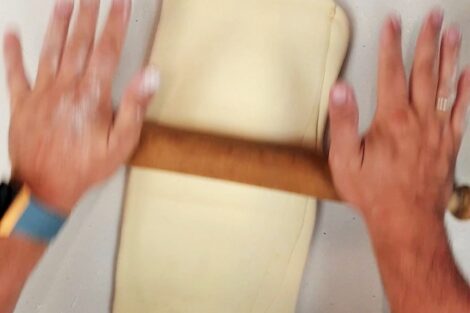
-
Brush any excess of flour.
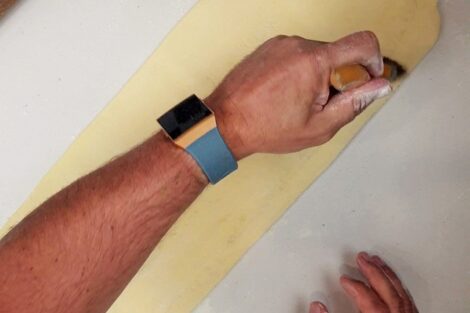
-
Grab the top third and fold to 2/3rd down.

-
Brush the excess of flour again.
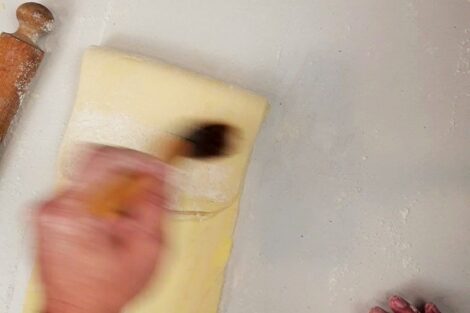
-
Grab the bottom third and fold it over.
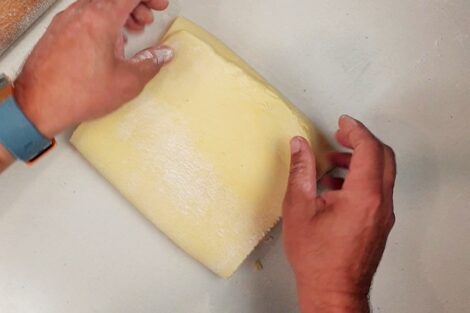
-
Turn the dough to a 90° rotation clockwise with again the big ply on your left hand-side again. this is your second turn .. cover with plastic wrap again and rest in the fridge.. you need to repeat the same action 4 more times. Repeat this process until you have done a total of 6 turns. and let the dough rest for another 30 min. This can be done 1 to 3 days in advance. You can also freeze your dough for up to 3 months.
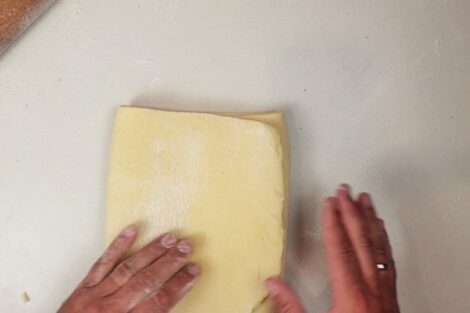
-
Once you are done your dough should show many small layers of pastry and butter as this one does. Use it straight away of keep it for later. make sure you cover it well... Check the blog post for more uses to this pastry and knowledge about it.
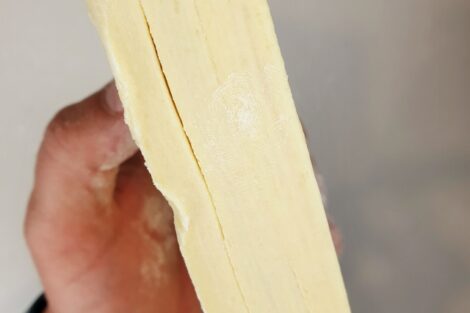
Notes
Nowadays you can get “convenient puff pastry “already rolled and made for you in many frozen sections of your local grocery shop. I must say it is convenient but you will never get the pastry to lift or raised as much as your own puff pastry and the taste will never be as good as your own. 1 tip if you use frozen pastry you will need to use 2 or 3 layers of the pastry on top of one another to aim for a final product that “looks” like home made one.
Take your time, this recipe can be made over few days, there is no rush. Once done you can keep it up to 5 days covered in the fridge or up to 6 months well wrapped in the freezer.



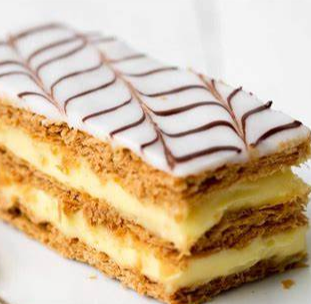
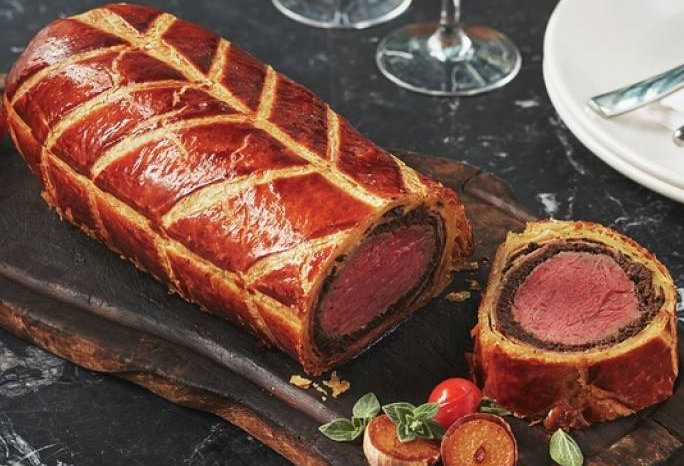
Excellent! Thank you for the detailed steps.
You are welcome Sandy 🙂
I just posted the recipe for the sourdough …. Video will be tomorrow